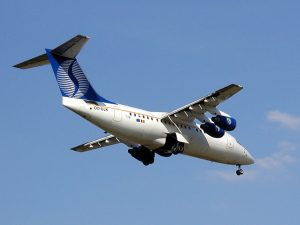
Have you heard of T-tail airplanes? Airplanes are often categorized according to their tail configuration. All airplanes have a tail. Also known as the empennage, it provides stability. In addition to V-tail and twin-tail airplanes, however, there are T-tail airplanes.
Overview of T-Tail Airplane
T-tail airplanes are characterized by the use of a T-shaped tail configuration. They feature a vertical tail fin. At the top of this fin is a horizontal tailplane or stabilizer.
You can see an example of a T-tail airplane in the adjacent photo. It depicts an Avro RJ-85 with a T-shaped tail configuration. There’s a vertical tail fin on the rear of the Avro RJ-85. Atop this vertical tail fin is a horizontal tailplane. The Avro RJ-85, of course, is just one of many T-tail airplanes. There are dozens of other commercial, as well as private, airplanes that use a T-shaped tail configuration.
Why Airplanes Use a T-Shaped Tail Configuration
You might be wondering why airplanes use a T-shaped tail configuration. While there are several other tail configurations, the T-shaped configuration is a popular choice for airplanes with nacelle- or fuselage-mounted engines.
If an airplane’s engines are mounted in nacelles or on the fuselage itself, exhaust gases may be projected toward the tail. This isn’t a concern for T-tail airplanes. The T-shaped tail configuration protects the tail from exhaust gases. As the engines release exhaust gases, they’ll still be projected toward the back of the airplane. But they won’t interfere with the T-shaped tail.
Another benefit of using a T-shaped tail configuration is spin recovery. Pilots can recover from spins more easily when controlling a T-tail airplane. A spin is a type of stall condition that involves a deeper stall for one of the wings than the other wing. When this occurs, the airplane will literally spin. With a T-shaped tail configuration, pilots can recover from spins more easily.
But there are some disadvantages associated with T-tail airplanes. They are susceptible to flutter, for instance. Manufacturers can design the fuselage with a stronger, harder material, but many T-tail airplanes are still susceptible to flutter.
There are also maintenance issues associated with T-tail airplanes. The tail configuration is more difficult to access from the ground, for example. This is due to the fact that T-shaped tail configurations are taller than conventional tail configurations.
In Conclusion
T-tail airplanes are distinguished from other types of airplanes by their T-shaped tail. They feature a vertical tail fin that’s affixed with a horizontal tailplane.



